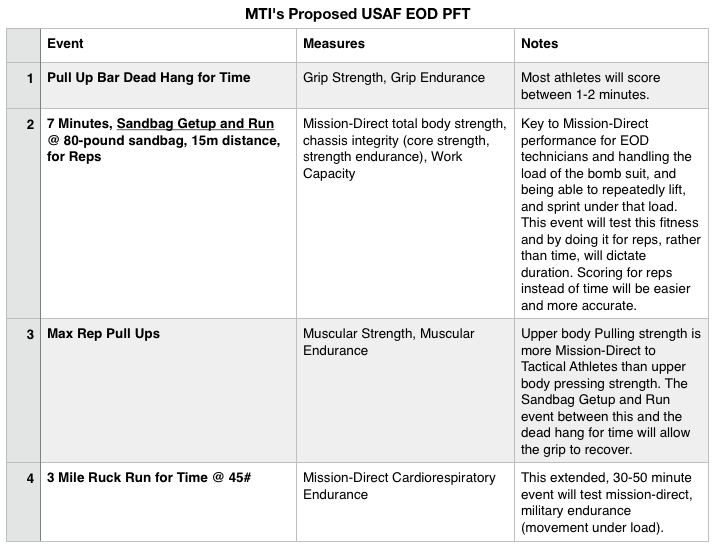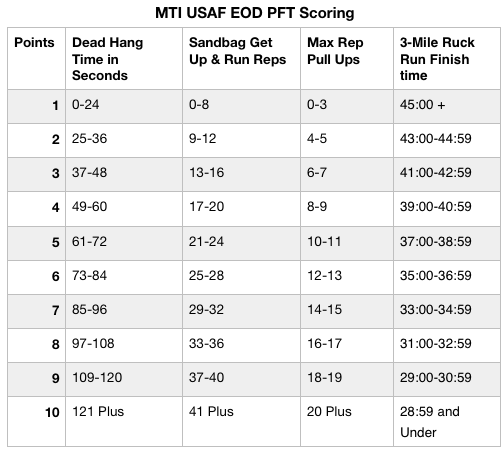
By Rob Shaul
Few have designed as many mission-direct fitness assessments as us here at MTI. We’ve made several mistakes in fitness assessment design, and have learned lessons along the way. In general, the more direct, focused and simple the fitness assessment, the better.
MTI’s Fitness Assessment Design Rules:
Assessment Must Test the Primary, Mission-Direct Fitness Demands of the Job
First step in designing any fitness assessment is to assess the primary fitness demands of the actual job. “Primary fitness demands” is key here and we find may strength and conditioning coaches and exercise science professors overthink this and develop and overly-complicated fitness assessment which extends into and attempts to assess textbook-driven general fitness components and/or periphery job fitness demands. Identifying the primary fitness demands of the job is the foundational step of any fitness assessment design, and this takes focused discipline. It’s tempting to add esoteric events with the goal of being thorough, but this quickly reaches a point of diminishing returns, and without focus, the assessment becomes cluttered, too long, too hard to asses, and too complicated to score.
Don’t Use Limited or Specialized Equipment
Issue here is not only access to equipment for the actual assessment but also access to the equipment to train with. Tactical fitness assessments are “high jeopardy” events for the tactical athletes who take them. Poor fitness assessment performance at best can negatively affect job evaluation performance, and at worse, result in job loss. It’s simply unfair to design a fitness assessment for tactical professionals which uses specialized equipment that is either rare, single-source, expensive, and/or not readily available.
Avoid Redundancy
Pick just one event to assess each primary, mission-direct fitness demand. Don’t deploy multiple fitness events to assess just one fitness demand. For example, if max effort lower body strength is a primary mission-direct fitness demand, don’t include both a 1RM Back Squat and 1RM Front Squats in the fitness assessment. Choose just one exercise to measure lower body strength and move on to the next primary demand.
Easy to Administer and Score
Simple is always better. A fitness assessment which is difficult to administer due to design, limited and/or specialized equipment, exercise complication or range of movement determination can quickly collapse under its own weight. Complication in scoring includes not only the overall assessment score but how to score individual events.
Doesn’t Take All Day
Two hours tops for 30+ athletes, including an endurance event. Ninety-minutes is better. High jeopardy fitness assessments are stressful events for professional tactical athletes, we owe it to them to get them in, get it done and get it over with. Limited equipment, or difficulty in scoring can quickly lead to bottlenecks which can slow stuff up significantly. For example, if max rep pull ups are an assessment event, and the unit has just one pull up bar for 30 athletes, things slow down. A two-hour time limit, including rest periods, will help in the fight against overcomplicated, redundant, difficult to score, fitness assessments.
The Battlefield Airman EOD Tier II PFT
Below are the new USAF Battlefield Airman Physical Fitness Test events, what they measure, and notes. This information comes from the USAF “Tier 2 Physical Fitness Tests and Standards,” .pdf document dated April, 2019. Read the document HERE.

Below are the problems I find with the test. I understand it’s easy to criticize, so at the end of my criticisms, I offer my own replacement for the Battlefield Airman EOD Tier II PFT.
1. Rowing Fitness, Medicine Ball Throws, and Hand Dynamometer Grip Strength are not primary mission-direct fitness demands for tactical athletes and use specialized equipment.
USAF EOD technicians don’t row anywhere and the transfer of rowing-fitness to running, rucking is not direct as the rower supports the athlete’s bodyweight. In the USAF’s testing of this event, athletes finished in 3:30-4:30, fairly close in time to a timed 1-mile run assessment, which would be more mission-direct for EODs.
The Medicine Ball Throws assess muscular power, a general fitness fitness attribute. EOD technicians don’t throw medicine balls on the job. A better measure of mission-direct power would be a short, timed sprint from prone.
The Hand Dynamometer grip strength test is another common, general fitness fitness test, which unlike grip endurance, may or may not be Mission Direct for EODs.
Both events use specialized equipment which may or may not be readily available. The required rower is a “Concept 2 Model D Row Ergometer with PM2, PM3, PM4 or PM5 Module,” and the rower’s drag setting has to calibrated for each athlete. To test 30 athletes efficiently, 10x rowers would be required.
The Medicine Ball Throw requires a 20-pound medicine ball, “14-inch diameter” medicine ball. Diameter is important as a smaller diameter ball would be easier to throw. Also important is the surface texture of the ball – an easier to grip surface texture would be an advantage.
Technique is also important in both events – especially the rower.
2. Special Equipment Required
In addition to a Concept 2 Rower and 20-pound, 14-inch diameter medicine ball, this assessment requires a Lafayette brand hand dynamometer, trap bar, 2x 50 pound sandbags (brand unspecified), 30-pound weight vest and 3×3 inch Beam barbell.
Stateside, it’s safe to assume units will have access to Concept 2 rowers, but it’s possible 14-inch medicine balls, and likely that 50-pound sandbags, a Lafayette hand dynamometer, and 30-pound weight vest will all have to be purchased specifically for this test.
The specific model of Lafayette dynamometer isn’t specified, and Lafayette lists at least 4 different hand dynamometers at its website, which will add to confusion. As well, to be fair, the dynamometer may need to be calibrated prior to each athlete being tested.
Trap bars aren’t currently common in most weight rooms.
Sandbags are becoming more common, but the specific type/brand of bag for this assessment is not specified. A larger bag, with less dense filler, will be more difficult to move for the Gruseter than a smaller bag filled with sand.
The 3×3-inch Beam for the grip endurance test as far as we can discern is only made by Rogue Fitness. Not sure what would happen if Rogue discontinued this product.
3. Athletes May Not Be Able To Train for the Assessment
Its likely units will protect the testing equipment from possible damage/loss between testing days, which will limit the ability of athletes to train for the assessment. As well, we could find no academic research on how to train event-specifically for the hand dynamometer assessment.
4. Event Redundancy
Multiple events assess grip strength and grip endurance either directly or peripherally including the 1000m Row, Hand Dynamometer Grip Strength Test, Trap Bar Dead Lift, Pull Ups, Farmer’s Carry and Medicine ball throw.
Three events assess Anaerobic capacity – 1000m Row, Farmer’s Carry, and Gruseter. The row and Greseter finish times overlap in duration – which indicates they could both be assessessing a similar measure of Anaerobic Capacity. The Row finish times for scoring extend from 3:31 to 4:33, while the Gruseter times from 4:07 to 6:59.
Both the Gruseter and the Extended Cross Knee Crunch test core strength.
5. Over Complication
Redundant events, requiring specialized equipment, the number of events, and events which are difficult to administer all add up to an overly complicated fitness assessment.
6. Takes too long
Ten events alone will take time to administer. Add in specialized equipment which will lead to bottlenecks in testing flow (hand dynamometer, rowers, Gruseter), minimum wait time between events, and a mandatory 1-3 day rest before the 1.5 mile run combine to end with a fitness test which takes several hours to administer spread out over two days.
The 5RM Deadlift requires a 5 minute minimum rest between events, and doesn’t have a prescribed warm up. Not enough barbells, and/or multiple athletes, plus the required wait time between efforts, could lead to a serious bottleneck.
MTI’s Suggested USAF EOD PFT
The 4-Event Assessment below, which will take approximately 90 minutes to administer:
Required Equipment
-
- Pull up bar
- 80-pound Sandbag
- 45-pound ruck

Scoring
– 40 Points Total (see chart below)
General Score Total Points
Poor 0-20
Good 21-35
Excellent 36-50

Questions, Comments, Feedback? Email rob@mtntactical.com
You Might Also Like 7 Major Problems with the Proposed Army Combat Readiness Test & Our Proposed Replacement for the APFT
